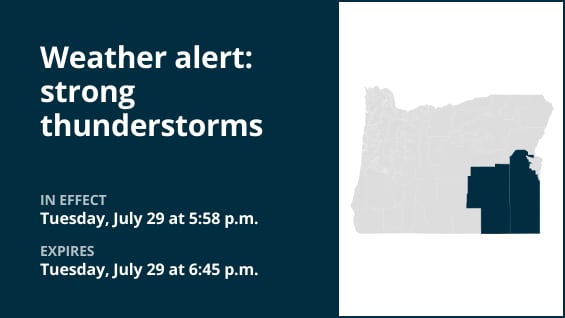At 5:58 p.m. on Tuesday, the National Weather Service updated its forecast, predicting severe thunderstorms in Harney and Malheur counties through 6:45 p.m.
Wind gusts of up to 50 mph and marble-sized hail (0.5 inches) are possible during the storms.
Strong thunderstorms were detected by Doppler radar at 5:56 p.m. in a line that ran from Alkali Lake to Burns Junction. The weather service said that the movement was heading north at 15 mph. Gusty winds have the potential to blow around unsecured objects and topple tree branches. Visibilities are decreased in areas when dust is blowing. It is possible for outdoor items to sustain minor harm.
Weaver Lake, Stinking Lake, Foster Lake, Venator Reservoir, Juniper Mountain, Baca Lake, Page Springs Campground, Frenchglen, New Princeton, Narrows, Burns Junction, Page Springs Campground, Malheur Cave, and Wagontire are among the places affected by the warning.
“If outside, consider seeking shelter inside a building,” the weather agency advises. These storms are also bringing torrential rains, which might cause localized flooding. Avoid operating a car on flooded roads.
Shielding yourself from approaching lightning: Expert safety guidelines
Approximately 25 million lightning strikes occur in the United States annually, most of which take place in the summer. The weather service reports that lightning is the cause of death for about 20 persons each year. As thunderstorms get closer, the risk of lightning increases; it peaks when the storm is directly overhead and then progressively decreases as it passes.
Think about the following suggestions to make sure you’re safe during a thunderstorm.:
Plan for lightning safety:
-
When venturing outdoors, it’s crucial to have a lightning safety plan in place.
-
Stay vigilant by monitoring the sky for ominous signs and listening for the telltale sound of thunder. If thunder is audible, it’s a clear indication of nearby lightning.
-
Seek a safe place to shelter, preferably indoors.
Indoor safety precautions:
-
Once you’ve found shelter indoors, abstain from using corded phones, electrical appliances, or plumbing fixtures, and refrain from approaching windows and doors.
-
These precautions help reduce the risk of electrical surges, as lightning can follow conductive pathways.
Hold off till the all-clear:
-
After the last lightning strike or thunderclap, wait at least 30 minutes before resuming outdoor activities.
-
Lightning can strike even when a storm has seemingly passed, so exercise caution.
When there is no indoor shelter:
Take these precautions to increase your safety if you are outside during a thunderstorm without access to inside shelter:
-
Avoid open fields, hilltops, or ridge crests, as they expose you to greater lightning risk.
-
Steer clear of tall, isolated trees and other prominent objects. In forested areas, stay close to lower stands of trees.
-
If you’re in a group, ensure that individuals are spaced out to prevent lightning current from transferring between people.
-
Camping in an open setting during a thunderstorm is strongly discouraged. If no alternative exists, set up camp in a valley, ravine, or other low-lying areas. Remember that a tent offers no protection against lightning.
-
Do not approach water bodies, wet objects, or metal items. Although water and metal do not attract lightning, they conduct electricity effectively and can pose significant risks.
In conclusion, being alert and ready are your best defenses against lightning threats. You may put your safety first and drastically lower the likelihood of lightning-related mishaps by adhering to these rules.
Rainy roadways ahead: Essential safety tips for heavy rain
Safety comes first when there is a lot of rain. To avoid dangers and navigate wet roads, arm yourself with these weather service guidelines:
Watch out for swift water flow:
Avoid parking or strolling close to drainage ditches or culverts during periods of intense rain, since the swift-moving water can be quite dangerous.
Keep your distances from other vehicles safe:
In heavy rain, the two-second rule of following distance is your friend. To guarantee safe spacing under unfavorable circumstances, increase it to four seconds.
Slow down and drive carefully:
It’s crucial to slow down on wet roads. To avoid sliding, reduce the accelerator gradually and don’t brake suddenly.
Pick your lane carefully:
To reduce the chance of hydroplaning, stay in the middle lanes. Water is more likely to accumulate in outside lanes.
Visibility is important.
Turn on your headlights to improve visibility in severe rain. Rain-stained windows can make it difficult to see cars in blind spots, so be especially alert for them.
Be cautious on slick roads:
Because of a combination of rain, oil, and grime, roadways are at their slickest during the first 30 minutes of precipitation. Be especially careful during this time.
Stay a safe distance away from big cars:
Tire spray from big vehicles and buses can make it harder to see. Pass them quickly and safely, and refrain from tailgating.
Be mindful of your wipers:
Visibility may be hampered by overloaded wiper blades. If the rain significantly impairs your vision, stop and wait for the weather to clear up. Take cover at rest areas or other safe places.
If you can’t avoid the roadside, pull off as far as you can, ideally past the end of a guard rail, and wait for the storm to pass. To let other cars know where you are, turn on your emergency flashers and keep your headlights on.
Taking these safety measures will significantly improve your road safety while it’s raining a lot. For a safe trip, keep yourself updated on weather conditions and follow local authorities’ instructions.
United Robots offers a service called Advance Local Weather Alerts that gathers the most recent information from the National Weather Service using machine learning.





More Stories
Update: Marble-sized hail foreseen with thunderstorms in Harney and Malheur counties Tuesday – gusts to hit 50 mph
Update: Marble-sized hail foreseen with thunderstorms in Harney and Malheur counties Tuesday – gusts to hit 50 mph
Update: Marble-sized hail foreseen with thunderstorms in Harney and Malheur counties Tuesday – gusts to hit 50 mph